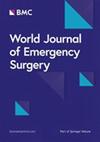胸外伤住院患者静脉血栓栓塞的风险预测模型:一项机器学习、全国多中心回顾性研究
IF 5.8
1区 医学
Q1 EMERGENCY MEDICINE
引用次数: 0
摘要
早期治疗和预防是降低胸外伤后静脉血栓栓塞死亡率的关键。本研究旨在开发并验证一种基于机器学习的VTE风险自动预测模型,用于胸部创伤患者的VTE风险筛查。在这项全国性多中心回顾性研究中,收集了2020年10月至2021年9月在中国33家医院住院的胸外伤患者的临床资料,进行模型训练和检验。纳入上海市第六人民医院2021年10月至2022年9月收治的胸外伤患者数据进行进一步验证。主要通过受试者工作特征曲线下面积(AUROC)和平均准确度(mAP)来衡量模型的性能,同时衡量模型的敏感性、特异性、阳性预测值和阴性预测值。共纳入3116例患者进行模型的训练和验证。在408例患者中进行了外部验证。随机森林(random forest, RF)模型作为最终模型,测试数据集的AUROC为0.879 (95% CI为0.856 - 0.902)。外部验证的AUROC为0.83 (95% CI 0.794-0.866),特异性为0.756 (95% CI 0.713-0.799),敏感性为0.821 (95% CI 0.692-0.923),阴性预测值为0.976 (95% CI 0.958-0.993),阳性似然比为3.364。该模型可用于快速筛选胸外伤患者静脉血栓栓塞的风险。可以避免90%以上不必要的静脉血栓栓塞检查,这可以帮助临床医生针对高危人群进行干预,并确保资源优化。虽然需要进一步的验证和改进,但本研究具有相当的临床价值。本文章由计算机程序翻译,如有差异,请以英文原文为准。
A risk prediction model for venous thromboembolism in hospitalized patients with thoracic trauma: a machine learning, national multicenter retrospective study
Early treatment and prevention are the keys to reducing the mortality of VTE in patients with thoracic trauma. This study aimed to develop and validate an automatic prediction model based on machine learning for VTE risk screening in patients with thoracic trauma. In this national multicenter retrospective study, the clinical data of chest trauma patients hospitalized in 33 hospitals in China from October 2020 to September 2021 were collected for model training and testing. The data of patients with thoracic trauma at Shanghai Sixth People’s Hospital from October 2021 to September 2022 were included for further verification. The performance of the model was measured mainly by the area under the receiver operating characteristic curve (AUROC) and the mean accuracy (mAP), and the sensitivity, specificity, positive predictive value, and negative predictive value were also measured. A total of 3116 patients were included in the training and validation of the model. External validation was performed in 408 patients. The random forest (RF) model was selected as the final model, with an AUROC of 0·879 (95% CI 0·856–0·902) in the test dataset. In the external validation, the AUROC was 0.83 (95% CI 0.794–0.866), the specificity was 0.756 (95% CI 0.713–0.799), the sensitivity was 0.821 (95% CI 0.692–0.923), the negative predictive value was 0.976 (95% CI 0.958–0.993), and the positive likelihood ratio was 3.364. This model can be used to quickly screen for the risk of VTE in patients with thoracic trauma. More than 90% of unnecessary VTE tests can be avoided, which can help clinicians target interventions to high-risk groups and ensure resource optimization. Although further validation and improvement are needed, this study has considerable clinical value.
求助全文
通过发布文献求助,成功后即可免费获取论文全文。
去求助
来源期刊

World Journal of Emergency Surgery
EMERGENCY MEDICINE-SURGERY
CiteScore
14.50
自引率
5.00%
发文量
60
审稿时长
10 weeks
期刊介绍:
The World Journal of Emergency Surgery is an open access, peer-reviewed journal covering all facets of clinical and basic research in traumatic and non-traumatic emergency surgery and related fields. Topics include emergency surgery, acute care surgery, trauma surgery, intensive care, trauma management, and resuscitation, among others.
 求助内容:
求助内容: 应助结果提醒方式:
应助结果提醒方式:


